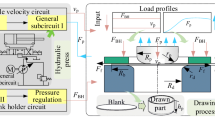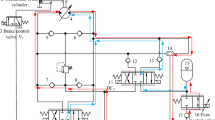Abstract
In this study, a novel double-stage hydraulic system incorporating a hydraulic controllable accumulator (HCA) was proposed to simultaneously improve the energy and working efficiency of the hydraulic fineblanking press. Within this system, an innovative controller was proposed to orchestrate the HCA’s operations, allowing it to adeptly adapt to abrupt pressure fluctuations and the energy demands from the external load. Within this study, a meticulous analysis was conducted to assess the energy demands of the fineblanking process and the function requirements of the hydraulic system. Subsequently, the energy consumption model based on the energy conservation law was established to analyze the supply–demand relationship of each stage and the energy conversion characteristic of capacitive energy, inertial energy, and resistive energy, thereby calculating these key parameters of the HCA. Then, an accurate simulation model was meticulously established and ultimately validated by the 1000-ton hydraulic fineblanking press, enabling a comprehensive assessment of the system’s working performance and energy consumption characteristics. The simulation and experimental results showed that within this proposed system, the main cylinder circuit accounted for a big part of energy consumption, three times higher than that of the fast cylinder circuit. In the fast cylinder circuit, both resistive and capacitive energy were prominent, whereas in the main cylinder circuit, capacitive energy took precedence. Compared to the traditional system, the proposed system performed better with lower system pressure fluctuation and higher working efficiency increased by 10%. Moreover, the energy efficiency of the proposed system reached 45.9%, 20.35% higher than that of the traditional system, resulting in a reduction in energy consumption of 169.4 kJ per duty cycle.






















Similar content being viewed by others
Abbreviations
- FC:
-
Fast-closing stage
- AD:
-
Anomaly detection stage
- FB:
-
Fineblanking stage
- UP:
-
Pressure unloading stage
- FO:
-
Fast-opening stage
- PID:
-
Proportion integration differentiation
- A j :
-
Contact area between the piston and the cylinder block (mm2)
- c :
-
Flow coefficient of cartridge valves (Null)
- C ic :
-
Cylinder leakage coefficient (W/bar2)
- C s :
-
Pump leakage flow rate (Null)
- d c :
-
Valves spool diameter (mm)
- B c :
-
Friction coefficient (N/m2)
- k 1, k 2 :
-
Constant parameters of motor (Null)
- q d :
-
Overflow flow (m3/s)
- l :
-
Pipe length (mm)
- n p :
-
Pump rotational speed (r/min)
- P a :
-
Valve input pressure (Pa)
- P b :
-
Valve output pressure (Pa)
- p e :
-
Motor power loss (W)
- p f :
-
Pipe local loss (W)
- p j :
-
Power loss along in parallel pipe (W)
- p n :
-
Motor nominal power (W)
- l :
-
Pipe length (mm)
- p s :
-
Overflow pressure
- p u :
-
SAM output power (W)
- T out :
-
Pump output torque (Nm)
- T fic :
-
Pump internal friction torque (Nm)
- v t :
-
Oil velocity in pipe (m/s)
- x 0 :
-
Spool displacement (mm)
- p u :
-
SAM output power (W)
- L 1 :
-
FC stroke
- L 2 :
-
AD stroke
- L 3 :
-
Whole stroke of the slider
- x 1 :
-
Target displacement signal
- η v :
-
Pump volumetric efficiency (Null)
- η m :
-
Pump mechanical efficiency (Null)
- μ :
-
Dynamic viscosity of the oil (Ns/m2)
- ρ :
-
Oil density (kg/m3)
- α :
-
Valves spool cone angle (°)
- λ :
-
Resistance coefficient
- Δq :
-
Pump leakage flow (m3/s)
References
Lu Y, Ma Z, Xue Y (2023) Towards advanced manufacturing systems for large parts: a review. Int J Adv Manuf Technol 125:3003–3022. https://doi.org/10.1007/s00170-023-10939-8
Arman S, Lazoglu I (2023) A comprehensive review of injection mold cooling by using conformal cooling channels and thermally enhanced molds. Int J Adv Manuf Technol 127:2035–2106. https://doi.org/10.1007/s00170-023-11593-w
Sun M, Cai Z, Yang C, Zhang H (2023) Digital twin for energy-efficient integrated process planning and scheduling. Int J Adv Manuf Technol 127:3819–3837. https://doi.org/10.1007/s00170-023-11755-w
El abdelaoui FZ, Jabri A, Barkany AE (2023) Optimization techniques for energy efficiency in machining processes—a review. Int J Adv Manuf Technol 125:2967–3001. https://doi.org/10.1007/s00170-023-10927-y
Yan X, Chen B, Zhang D, Wu C, Luo W (2019) An energy-saving method to reduce the installed power of hydraulic press machines. J Cleaner Prod 233:538–545. https://doi.org/10.1016/j.jclepro.2019.06.084
Nürnberger A, Müller D, Martinitz L, Hartmann C, Thomas T, Stahl K, Volk W (2023) Advantages in the production of power transmitting gears by fineblanking. Int J Adv Manuf Technol. https://doi.org/10.1007/s00170-023-12160-z
Xu Z, Liu Y, Hua L, Zhao X, Wang X (2020) Energy improvement of fineblanking press by valve-pump combined controlled hydraulic system with multiple accumulators. J Cleaner Prod 257:120505. https://doi.org/10.1016/j.jclepro.2020.120505
Xu Z, Liu Y, Hua L, Zhao X, Guo W (2019) Energy analysis and optimization of main hydraulic system in 10,000 kN fine blanking press with simulation and experimental methods. Energy Convers Manage 181:143–158. https://doi.org/10.1016/j.enconman.2018.12.012
Khajvand F, Zareinejad M, Mehdi Rezaei S, Baghestan K (2023) Design and implementation of a series hydraulic hybrid propulsion system to increase regenerative braking energy saving range. Energy Convers Manage 279:116754. https://doi.org/10.1016/j.enconman.2023.116754
Yan X, Chen B, Yin F, Ji H, Ma Z, Nie S (2023) Energy optimization of main hydraulic system in a forging press by simulation and experimental methods. Energy 277:127620. https://doi.org/10.1016/j.energy.2023.127620
Zhao K, Liu Z, Yu S, Li X, Huang H, Li B (2015) Analytical energy dissipation in large and medium-sized hydraulic press. J Clean Prod 103:908–915. https://doi.org/10.1016/j.jclepro.2014.03.093
Mahato AC, Ghoshal SK (2021) Energy-saving strategies on power hydraulic system: an overview. Proceedings of the Institution of Mechanical Engineers, Part I: Journal of Systems and Control Engineering 235:147–169. https://doi.org/10.1177/0959651820931627
Yan X, Nie S, Chen B, Yin F, Ji H, Ma Z (2023) Strategies to improve the energy efficiency of hydraulic power unit with flywheel energy storage system. Journal of Energy Storage 59:106515. https://doi.org/10.1016/j.est.2022.106515
Yao J (2016) Energy saving and control of hydraulic press fast forging system based on the two-stage pressure source. Journal of Mechanical Engineering 52:199. https://doi.org/10.3901/JME.2016.10.199
Xu B, Huang X, Zhang J, Huang W, Lyu F, Xu H (2023) A fault detection method for a practical electro-hydraulic variable-displacement pump with unknown swashplate moment. IEEE Trans Instrum Meas 72:1–11. https://ieeexplore.ieee.org/abstract/document/10093939/
Fresia P, Rundo M, Padovani D, Altare G (2022) Combined speed control and centralized power supply for hybrid energy-efficient mobile hydraulics. Autom Constr 140:104337. https://doi.org/10.1016/j.autcon.2022.104337
Lin T, Lin Y, Ren H, Chen H, Li Z, Chen Q (2021) A double variable control load sensing system for electric hydraulic excavator. Energy 223:119999. https://doi.org/10.1016/j.energy.2021.119999
Wen Q, Wang F, Xu B, Sun Z (2020) Improving the fuel efficiency of compact wheel loader with a series hydraulic hybrid powertrain. IEEE Trans Veh Technol 69:10700–10709. https://doi.org/10.1109/TVT.2020.3006155
Tan P, Liu X, Liu C, Zhang C, Chen W, Cao B, Yang K, You T (2022) Investigating the matching characteristic of the full hydraulic braking system of the wheel loader. J Braz Soc Mech Sci Eng 44:209. https://doi.org/10.1007/s40430-022-03452-8
Li L, Huang H, Zhao F, Triebe M, Liu Z (2017) Analysis of a novel energy-efficient system with double-actuator for hydraulic press. Mechatronics 47:77–87. https://doi.org/10.1016/j.mechatronics.2017.08.012
Huang H, Zou X, Li L, Li X, Liu Z (2019) Energy-saving design method for hydraulic press drive system with multi motor-pumps. International Journal of Precision Engineering and Manufacturing-Green Technology 6:223–234. https://doi.org/10.1007/s40684-019-00085-6
Dang TD, Phan CB, Ahn KK (2019) Design and investigation of a novel point absorber on performance optimization mechanism for wave energy converter in heave mode. International Journal of Precision Engineering and Manufacturing-Green Technology 6:477–488. https://doi.org/10.1007/s40684-019-00065-w
Chen Q, Lin T, Ren H, Fu S (2019) Novel potential energy regeneration systems for hybrid hydraulic excavators. Math Comput Simulation 163:130–145. https://doi.org/10.1016/j.matcom.2019.02.017
Ge L, Dong Z, Quan L, Li Y (2019) Potential energy regeneration method and its engineering applications in large-scale excavators. Energy Convers Manage 195:1309–1318. https://doi.org/10.1016/j.enconman.2019.05.079
Wang R, Gu F, Cattley R, Ball AD (2016) Modelling, testing and analysis of a regenerative hydraulic shock absorber system. Energies 9:386. https://doi.org/10.3390/en9050386
Chen Q, Yue X, Geng D, Yan D, Jiang W (2020) Integrated characteristic curves of the constant-pressure hydraulic power take-off in wave energy conversion. Int J Electr Power Energy Syst 117:105730. https://doi.org/10.1016/j.ijepes.2019.105730
Liu Y, Xu Z, Hua L, Zhao X (2020) Analysis of energy characteristic and working performance of novel controllable hydraulic accumulator with simulation and experimental methods. Energy Convers Manage 221:113196. https://doi.org/10.1016/j.enconman.2020.113196
Acknowledgements
The authors would like to thank Huangshi Huali Metal Forming Machine Tool Co., Ltd, for providing the technology parameters. The authors also thank the Fundamental Research Funds for the Central Universities WUT:501 2019III117CG, 111 Project (B17034), Innovative Research Team Development Program of 502 Ministry of Education of China (No. IRT_17R83), for the financial support given to this research.
Author information
Authors and Affiliations
Contributions
Zhicheng Xu: methodology, characterizations, and writing first draft. Lin Hua: review and editing and financial support. Yanxiong Liu: supervision and final draft. All authors have read and agreed to publish the manuscript.
Corresponding authors
Ethics declarations
Ethics approval
The article follows all the guidelines for publication in the journal.
Consent to participate
All authors are agreeing to participate in this research study.
Consent for publication
All authors are agreeing to publish this work.
Competing interests
The authors declare no competing interests.
Additional information
Publisher's Note
Springer Nature remains neutral with regard to jurisdictional claims in published maps and institutional affiliations.
Rights and permissions
Springer Nature or its licensor (e.g. a society or other partner) holds exclusive rights to this article under a publishing agreement with the author(s) or other rightsholder(s); author self-archiving of the accepted manuscript version of this article is solely governed by the terms of such publishing agreement and applicable law.
About this article
Cite this article
Xu, Z., Hua, L. & Liu, Y. Energy saving and performance enhancement of hydraulic fineblanking press assisted with controllable hydraulic accumulator for sustainability. Int J Adv Manuf Technol 131, 1119–1136 (2024). https://doi.org/10.1007/s00170-024-13082-0
Received:
Accepted:
Published:
Issue Date:
DOI: https://doi.org/10.1007/s00170-024-13082-0




